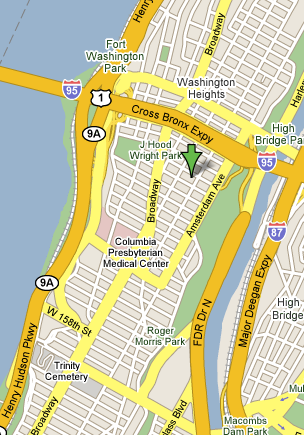Washington Heights
From Decoding New York
| Introduction |
| Washington Heights |
| * Evolution |
| * Here v. There |
| * What's Real |
| * Economy |
| Rego Park |
| * Evolution |
| * Here v. There |
| * Economy |
| Comparison |
| * Photo Gallery |
| * Sources
|
Washington Heights is located in the Northern-most region of Manhattan's West side. It is spread between 145th and 200th street, and includes well-known sites and locations like the Cloisters, the Washington Heights Museum Group, the American Numismatic Society, the Hispanic Society of America, the American Academy of Arts and Letters, and Yeshiva University (Garb 1). Immigrant groups as diverse as the Irish, Eastern European Jewish, Italian, German, Cuban, and Greek communities have, at one point in time, settled in this area (Dicker 722).
Washington Heights is also home to Fort Tryon Park. This park is a historically important site because of its long line of inhabitants and owners; originally the park was inhabited by Native Americans, early Dutch settlers, and both the Continental and British armies during the Revolutionary War. In addition, Fort Tyron park also includes the home of William Henry Hayes, and was eventually sold to John D. Rockefeller in 1917 (Renner 1).
The Cloisters, a home to medieval buildings and artifacts in Washington Heights, similarly received aid and economic funding from John D. Rockefeller as well as the Metropolitan Museum of Art. The Cloisters annually sponsors festivals celebrating and recreating medieval times (Renner 1).
Aside from its beautiful parks, Washington Heights' most populated areas are filled with various small, locally run stores and restaurants, as well as a number of small specialty vendor stands. In addition, the neighborhood streets contain various small housing complexes in red or white brick buildings, often offering four story housing above small stores. Upon observing the various languages of store signs, graffiti, and bill boards as well as the population groups that immigrant services seem to cater to, one can conclude that Spanish is the central language this neighborhood.
This section on Washington Heights and Rego Park developed by Irina Mullokandova, Karina Fatova, Quinn Marston.
